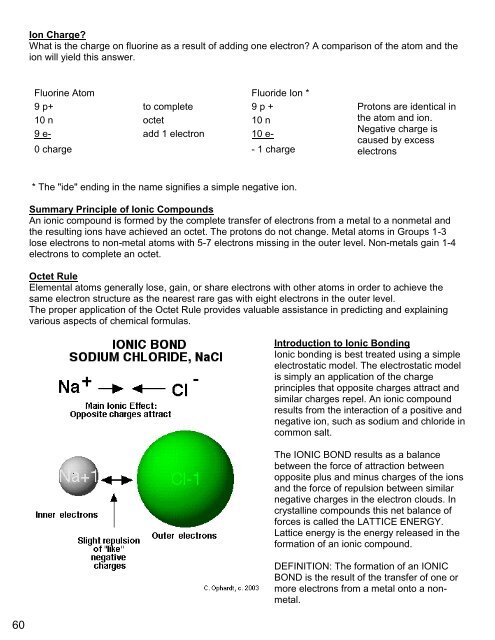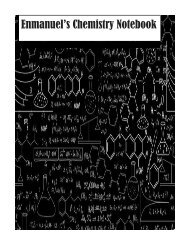Create successful ePaper yourself
Turn your PDF publications into a flip-book with our unique Google optimized e-Paper software.
Ion Charge?<br />
What is the charge on fluorine as a result of adding one electron? A comparison of the atom and the<br />
ion will yield this answer.<br />
Fluorine Atom Fluoride Ion *<br />
9 p+ to complete 9 p + Protons are identical in<br />
10 n octet 10 n<br />
9 e- add 1 electron 10 e-<br />
0 charge - 1 charge<br />
the atom and ion.<br />
Negative charge is<br />
caused by excess<br />
electrons<br />
* The "ide" ending in the name signifies a simple negative ion.<br />
Summary Principle of Ionic Compounds<br />
An ionic compound is formed by the complete transfer of electrons from a metal to a nonmetal and<br />
the resulting ions have achieved an octet. The protons do not change. Metal atoms in Groups 1-3<br />
lose electrons to non-metal atoms with 5-7 electrons missing in the outer level. Non-metals gain 1-4<br />
electrons to complete an octet.<br />
Octet Rule<br />
Elemental atoms generally lose, gain, or share electrons with other atoms in order to achieve the<br />
same electron structure as the nearest rare gas with eight electrons in the outer level.<br />
The proper application of the Octet Rule provides valuable assistance in predicting and explaining<br />
various aspects of chemical formulas.<br />
Introduction to Ionic Bonding<br />
Ionic bonding is best treated using a simple<br />
electrostatic model. The electrostatic model<br />
is simply an application of the charge<br />
principles that opposite charges attract and<br />
similar charges repel. An ionic compound<br />
results from the interaction of a positive and<br />
negative ion, such as sodium and chloride in<br />
common salt.<br />
The IONIC BOND results as a balance<br />
between the force of attraction between<br />
opposite plus and minus charges of the ions<br />
and the force of repulsion between similar<br />
negative charges in the electron clouds. In<br />
crystalline compounds this net balance of<br />
forces is called the LATTICE ENERGY.<br />
Lattice energy is the energy released in the<br />
formation of an ionic compound.<br />
DEFINITION: The formation of an IONIC<br />
BOND is the result of the transfer of one or<br />
more electrons from a metal onto a nonmetal.




